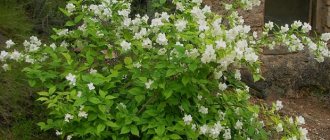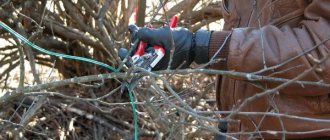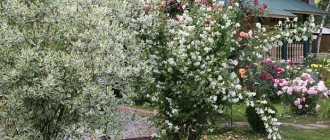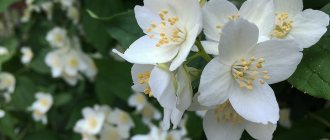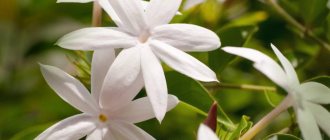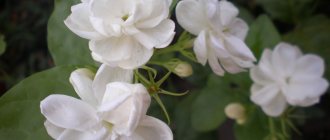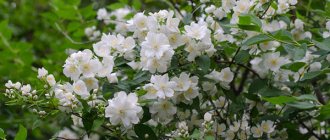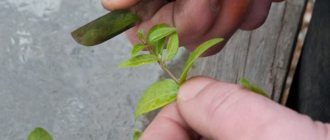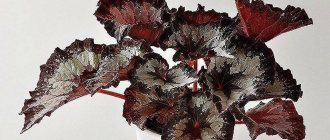4518
Some ornamental shrubs lend themselves well to formative pruning. Chubushnik is no exception to this list. Removing damaged and old shoots is necessary not only to maintain decorativeness, but also for the active growth of the shrub. By practicing regular pruning of mock orange in the spring and after flowering in the summer, you can achieve amazing results. Autumn sanitary procedures are also necessary to free the plant from weak and damaged branches.
Mock orange, derain, roses
Using self-harvested seeds
Propagation by seeds is a labor-intensive and time-consuming method, and 2-3 years can pass from the moment the first sprouts appear to the start of jasmine flowering. The gardener also needs to remember that varietal characteristics may not be preserved in hybrid species. The only advantage of such seed propagation is the fact that the gardener can immediately obtain a large amount of planting material by planting tens and hundreds of bushes on a large plot of land.
It is believed that seed material can be stored for about a year without loss of germination. It does not require a stratification procedure, which somewhat simplifies the subsequent planting of jasmine. Planting of seeds is carried out in autumn or spring; to root the seedlings, they are soaked for several hours in warm water or in various growth activators. Subsequent care will only involve watering and covering the plants for the winter.
The soil mixture in which the seeds are planted should consist of compost, turf and forest litter in a ratio of 1: 1: 2. Pre-sowing jasmine in a greenhouse or greenhouse shows excellent results, and no additional heating is required. Before the first shoots appear, frequent regular watering and slight darkening will be needed. One-day-old seedlings are sprayed with a weak solution of potassium permanganate, and picking is performed no earlier than three weeks later.
Methods for propagating jasmine
Like many other plants, jasmine or mock orange can grow from a seed, but this will take quite a lot of time. The question is, why wait if there is an accelerated method for obtaining healthy and strong seedlings within a few months?
Cuttings are the most successful and fastest way, allowing you to get several young seedlings at once. Summer is the best time to propagate jasmine and produce young plants.
For the reproduction process, green cuttings from a healthy and overgrown bush will be required. By mid-June, when the mother plant has completely flowered, you can begin harvesting cuttings. In order for the shoots to successfully take root and take root, you need to know certain rules.
- Take only one-year-old shoots for propagation.
- Cut only those shoots that differ in size and large leaf blades.
- You should not take shoots with long internodes for cuttings; the fact is that they are not capable of active development, much less flowering.
Propagation by seeds
They begin to collect seeds at the end of summer, when the mock orange flowers have faded and its seed pods have ripened. This breeding method is suitable only for the species forms of this ornamental shrub. As for plant hybrids, mock orange is propagated vegetatively.
Mock orange seedlings from seeds
How to propagate mock orange with seeds? This can be done in two ways, which depend on the time of year.
- Planting before winter. Pre-prepare the bed and make furrows. Then they are sown with seeds and covered with compost. Arches are installed over the garden bed and covered with spruce branches for the winter. After the snow has completely melted, the spruce branches are removed and instead covered with non-woven material to shade the hatching seedlings.
- Spring planting. This method allows you to grow seedlings at home. Seed collected in the fall should be used, but the storage period should not exceed more than 1 year. In addition, the storage conditions must be met: the seeds are stored in the refrigerator in a sealed bag. In spring they are planted in cups. In June, grown and strengthened seedlings are transplanted into the ground.
Important! Since it is not possible to propagate hybrid and garden varieties of mock orange so that all varietal characteristics are preserved, seeds can only be used from the species forms of “garden jasmine”.
How to propagate by layering?
To propagate mock orange bushes by layering, you must adhere to all the main stages of the procedure. It is best to start before the first buds appear on the shoots - in early spring. You need to dig up the ground around the plant, and then level the soil surface. It is recommended to wrap the cuttings that will be used to propagate the plant with thin wire three turns under the lower bud. In the process of further formation of the shoot, the wire will be pressed in, which will entail the appearance of roots in this place.
Before planting, you should prepare holes up to 1.5 centimeters deep. Then place cuttings in them, which are fixed with slingshots from small branches, and sprinkled with loosened soil. After some time, shoots will appear on the layering. When they reach 15 centimeters in length, you should hill them up to a height of 10 centimeters. After a week and a half, the procedure must be repeated and this must be done until the shoots reach 20 centimeters in length.
There is also a shrub method for growing garden jasmine. In this case, the cuttings are dug up in mid-autumn, after which they are divided according to the number of shoots with roots. It is advisable that their height does not exceed 70 centimeters. To prepare the plant for frost, it must be buried shortly before the onset of cold weather. In spring, mock orange is planted in open ground.
Only after a year has passed can young bushes be transplanted to a permanent location.
Reproduction by layering
How to propagate mock orange by layering is very simple. Reproduction by layering is a very effective and uncomplicated method. To do this, at the beginning of spring, before the buds open, the following actions are carried out:
- The soil around the bush needs to be dug up, fertilized and holes made 1.5-2 cm deep.
- Place layering in the holes, pour water on top and sprinkle with soil.
- The top of the layer is not buried; it must be tied to a peg so that its growth is vertical.
Important! For reliability, secure the mock orange shoots in the hole with slingshots made of twigs or wire.
After a while, roots and sprouts form from each bud on the buried shoot. As young shoots grow, they are hilled up to a height of 10-15 cm.
Reproduction of mock orange by layering
During the summer period, water and loosen the growing bushes. In the fall, cut cuttings from the main bush, dig them up and use pruning shears to divide them between the buds into bushes. Plant the prepared seedlings on the site.
Reproduction methods
Seminal
How to propagate mock orange from seeds and what will come of it? At the end of summer, seed boxes appear on faded bushes, which are collected for subsequent sowing. It must be said that the seed propagation method is used only for species forms of mock orange, while garden varieties are propagated only vegetatively.
Seeds are sown in two ways. In the first case, this is done before winter in the garden. To do this, make furrows in the garden bed and sow seeds, covering them with sand or compost. For the winter, the siftings are covered with spruce branches, which are removed after the snow melts in the spring, and the seedlings are shaded with non-woven material along arcs.
The second method is spring planting in cups for seedlings. It should be remembered that mock orange seeds do not retain germination well, for no more than a year, and they need to be stored in a sealed plastic bag in the refrigerator. Seedlings are grown until June, after which the seedlings are planted in open ground.
Cuttings
Mock orange is propagated by cuttings, both green and woody. For green cuttings, shoots are cut in mid-June.
Tips for propagating mock orange from green cuttings:
- when cutting, use only a sharp knife, no scissors or pruners;
- It is best to cut green shoots with a piece of an annual branch, with the so-called heel;
- the cutting should be five centimeters long with two pairs of leaves;
- the upper leaves need to be shortened by a third, and the lower leaves removed altogether;
- when cutting mock orange in summer, use a loose, moist substrate: soil with sand;
- before placing the cutting in the substrate, you need to make a hole in it a centimeter deep with some stick or finger;
- place the cutting in the prepared hole and gently squeeze the soil around it;
- after that, we spray the cuttings and cover them with a cut plastic bottle, non-fabric or film;
- We regularly remove the lid, ventilate and spray the taking root cuttings.
If everything is done correctly, then in October the finished seedling can be planted in a permanent place in the garden.
To propagate mock orange by cuttings in the spring, it is necessary to prepare material in the fall. For this purpose, one-year woody shoots are cut and stored wrapped in film in the cellar or lower compartment of the refrigerator.
Around mid-March, the shoots are taken out of the refrigerator and cuttings 15-20 centimeters long are cut from them, it is necessary that they have 3-4 pairs of buds. The upper cut is made straight, a centimeter above the bud, and the lower cut is made below the bud, at an angle of 45 degrees. After cutting, the cuttings are placed in a solution of some root formation stimulator for a day.
The prepared cuttings are planted obliquely in a loose substrate consisting of a mixture of sand and peat in a one-to-one ratio. To increase air humidity, the plantings are sprayed with water and covered with the top half of a plastic bottle, the lid of which is removed for ventilation.
The planted cuttings are regularly watered and sprayed. They spend about five weeks in this state until they are completely rooted. In mid-to-late May, seedlings are taken out into open ground.
By layering
It is very easy to propagate mock orange by layering. This is best done in the spring after the snow has melted and the soil is ready for sowing, around the end of April or the first ten days of May. The sequence of actions is as follows:
- We select one of the outer shoots and bend it to the ground.
- We mark a point for removing the bark at the point where the shoot comes into contact with the soil.
- At the marked point, remove the bark one centimeter wide.
- We pin the shoot to the ground using a piece of bent wire.
- Sprinkle the area where the bark was removed with soil, compact it and water it.
During the season, we check the condition of the cuttings and, if necessary, add soil and mulch. During prolonged dry weather, it is necessary to regularly water the layering site. By the end of the season, the rooted shoot can be separated from the bush and transplanted to a permanent place. The transplant can also be carried out in the spring of next year.
Dividing the bush
The method of propagating mock orange by dividing the bush is used in the case when the bush has been growing in one place for quite a long time and has grown significantly in width. In this case, the plant is dug up and divided into several parts, usually two or three; if the bush is huge, then division into more parts is possible.
When dividing, make sure that each part gets a sufficient number of roots. Excess shoots, as well as damaged and old ones, are cut out. It is advisable to transplant the divisions on the same day so that the roots do not have time to dry out. As a last resort, the plant needs to be buried and then planted. Work on dividing the bush should be carried out in late autumn or spring before the leaves bloom.
When can you reproduce?
Mock orange belongs to the Hydrangeaceae family, but is popularly called “garden jasmine.” The shrub received the Latin name “Philadelphus” in honor of the king of Egypt Ptolemy Philadelphus, and the Russian name “mock orange” - due to the fact that smoking pipes and mouthpieces were made from its hollow stem.
Chubushnik - garden decoration
The height of the bush is 1-2.5 m, the stems are flexible, thin, the leaves are light green and bright. Flowers are collected in inflorescences, which are formed on short lateral shoots. They can be simple, cup-shaped, goblet-shaped, semi-double or terry, white or cream shades.
Mock orange blooms at the end of June - July for 3 weeks, when the spring colors have already faded, garden jasmine begins to delight with its beauty and fragrance.
Mock orange is an unpretentious plant and can be propagated by all methods known in gardening. How mock orange jasmine reproduces:
The timing when reproduction can be carried out depends on the selected breeding method:
- The favorable period for dividing the bush is March-April.
- When propagating by cuttings, three methods are used: spring, summer and autumn-spring. Autumn harvesting of cuttings begins after the leaves fall. Lignified gray cuttings are cut and left for winter storage in a cellar or basement at a temperature of 3-5 ℃ above zero, while the stems are deepened into a container with wet sand. You can start planting in the spring, when the flower buds swell. When cutting in spring, young green shoots are chosen before the bush begins to flower; how to propagate mock orange by cuttings in the summer - after flowering.
- Seed propagation is carried out in the fall - in November or in the spring - in April.
- Layerings are strong, well-developed shoots, dug in at the end of April - beginning of May, throughout the season, you must not forget to water them, and in the fall, the cuttings that have taken root can already be transplanted to a permanent place of residence.
Post-transplant care basics
Young plants need careful care after transplantation. It is important not only for plants kept indoors. In open ground, cuttings also need to be looked after so that by autumn they become stronger, develop a root system and prepare for wintering.
How to care for jasmine in the garden
Transplanted rooted jasmine cuttings need regular watering. We must not forget that the root system of the plant has not yet been formed.
It is necessary to ensure such a watering regime so that the soil does not dry out, but is not too wet.
It is recommended to loosen the soil around the trunk of a young plant weekly. This procedure retains moisture in the soil well. And when the seedling begins to grow, you can begin to hill it. This has a beneficial effect on the development of the entire plant and strengthening its roots.
While the jasmine crown is not yet formed, you need to tie the growing cuttings to a support so that they do not fall down or break. And next spring you can pinch the top of the shoot so that the seedling begins to branch.
Caring for indoor jasmine
Typically, jasmine is grown indoors for 2-3 years. After this, the bush, even if annual formative pruning is carried out, becomes too large and bulky to grow indoors.
It is better to plant it in open ground. But while the plant is kept in the room, it needs to be watered regularly, preventing the soil from drying out.
Fertilizer is also a necessary part of plant care. It is better to feed young jasmine with fertilizers for decorative foliage plants.
This will allow it to quickly grow green mass and become stronger for planting on a personal plot.
While jasmine is growing in a pot, it needs to be replanted annually. It grows quickly and its roots become cramped in the pot. Every spring it needs to be replanted by transferring it to a larger pot.
Now you know how to propagate jasmine from cuttings in the summer.
How to propagate by dividing the bush?
This procedure is ideal for cases when there is a need to move the mock orange to another place. This method is also used when the plant grows strongly. It is recommended to replant garden jasmine with the onset of spring or autumn. Before this, the bush must be generously filled with water and left for a day, after which it must be carefully dug up. The root system should remain intact after digging. The roots must be thoroughly cleared of soil.
It is necessary to divide the bush into several parts. The main thing is that each part has the required number of roots. The lower part of the roots and shoots should be trimmed and then planted in the ground. Usually the plant is buried down to the buds located on the top of the cuttings. To disinfect the soil, before planting it is necessary to treat it with a manganese solution. It is also advisable to fertilize the soil well and then water the plants generously.
If you plant garden jasmine in the spring, the plant should take root in the ground within 3-5 weeks. By August, the mock orange root system will be fully formed and strengthened.
If you follow all the rules for propagating garden jasmine, you will be able to get a new plant that is well adapted to growing in the garden.
How to propagate juniper from cuttings
It is not difficult to take cuttings from a plant; the main thing is to know and follow all the subtleties so that the rooting process is successful and quick. Step-by-step instructions for the process are outlined below.
Preparation of planting material
First you need to choose the appropriate planting material. There are several rules:
- It is advisable to harvest cuttings from bushes older than 8 years - then the young growth will retain all the characteristics of the mother plant.
- When it is necessary to grow a spreading bush, the cutting should be cut from the middle part of the bush. If you need a vertical one - from the top. One mother bush will be enough to renew the planting.
- The shoot should be green. It needs to be cut early in the morning.
- When pruning, you should grab the part of the branch on which the shoot grew, so that it turns out with the so-called heel. This will speed up the rooting process.
- You need to divide the branch into pieces 12 cm long. It can be longer, but not more than 25 cm.
- It is necessary to harvest cuttings only with a sharp and sterile instrument.
How to properly prepare a cutting
The preparatory stages are as follows:
- Remove the needles on the shoot with a sharp knife without damaging the bark. The needles should remain only at the very top.
- Treat the bottom of the cutting with a growth stimulator or similar agent - you need to dilute sugar in warm water in a ratio of 1 to 2.
- A day later, plant the shoots in a nutrient substrate prepared in advance.
How to root a cutting
The nutrient substrate for juniper propagation must be loose, breathable, and moisture-absorbing. These characteristics correspond to a mixture of peat and sand, in equal proportions. For good air exchange, add a little charcoal and perlite.
Important! If several cuttings are planted, then there should be 6–8 cm between them. The rooting process looks like this:
The rooting process looks like this:
- The container is filled with soil mixture, in which a hole is formed 30–40 mm deep and 10 mm in diameter.
- A cutting is placed in the hole, the soil around it is compacted and irrigated abundantly.
- The period for the formation of viable roots is at least 25 days.
Rules for propagation by cuttings
Plant propagation by cuttings is very popular among gardeners. This method helps preserve all varietal characteristics of garden jasmine. It is recommended to collect shoots during seasonal pruning.
Cuttings with green shoots of mock orange in spring or early summer must be carried out according to the following rules of agricultural technology:
- in May - June you need to start pruning shoots from bushes; it is recommended to choose stems that have a so-called heel;
- the length of the cutting must be at least 5 centimeters, each of which must have two pairs of leaves;
- the leaves, which are located in the upper part of the stem, are shortened by almost a third, which is necessary to reduce moisture evaporation; the leaves located at the bottom of the shoots are completely removed.
- the soil mixture for planting must contain sand and soil; the cuttings are rooted 2 centimeters into the ground, after which the plant should be covered with film or plastic container;
- You can plant a sprout on the site in mid-autumn.
If you plan to propagate garden jasmine in the spring, then it is best to start harvesting planting material in the fall. In this case, not green shoots are used, but lignified ones. The collected sprouts should be wrapped in film and kept in a cool place all winter. At the beginning of spring, ready-made shoots should be cut into cuttings, the length of which should not exceed 15 centimeters. Make sure that there are at least 3 pairs of buds on each cutting. The upper cut should be made at a distance of one centimeter from the bud, and the lower cut at an angle of 45 degrees.
A day before planting, the cuttings are placed in a solution of a growth stimulator, after which they are kept in a substrate that contains peat and sand in proportions of one to one. Then the cuttings are covered with film. It is necessary to regularly ventilate and water the sprouts. Mock orange will be able to take root within 5 weeks from the moment of planting. After the first leaves appear, the plant is transplanted to a permanent place in open ground. From a twenty-centimeter seedling, garden jasmine can turn into a three-meter giant in just 5 years.
Important! Even a novice gardener can cope with breeding mock orange, since this process does not require enormous labor costs and time. It is necessary, as in most cases, to adhere to certain rules for pruning and caring for the plant.
Rules for planting seeds
Seed propagation technology requires the gardener to spend a lot of time and effort. This method is popular among breeders, since it is intended mainly for breeding new varieties of garden jasmine. The method of propagating mock orange by seeds is only suitable for specific varieties of shrubs. The thing is that this method can lead to the loss of varietal characteristics of the plant. After the mock orange fades, seed pods are formed over time, from which the fruits are collected for further sowing. The optimal time for sowing seeds is November and April.
It is worth considering the basic rules for sowing seeds in the autumn.
- After harvesting the fruits, they must be subjected to a stratification process. To do this, just place the seeds in a bag and put it in a cold place for 50–60 days.
- Before sowing, it is recommended to mix the seeds with sand, after which the mixture is scattered onto the surface of the soil. The seeds are covered with a small layer of compost on top. If there is no fertilizer, you can cover the crop with spruce branches.
- After the snow melts in the spring, the shelter is removed. When the seeds germinate, the seedlings need protection from direct sunlight; for this they are covered with agrofibre or a simple cloth.
It is worth following simple rules for sowing seeds in the spring.
- Before sowing, the seeds should be placed in a small fabric bag and kept in water for 2 hours, the temperature of which should not be lower than room temperature. After this, the bag of seeds is placed in sawdust for 72 hours. Instead of sawdust, you can use moistened peat. After three days, the fruits must be dried, then mixed with sand and sowing begins.
- At the beginning of spring, the seeds are sown in a small container filled with soil mixture. A thin layer of sand is poured on top of the seeds and then sprayed with water. It is best to cover the sowing with film or glass.
- At first, the soil should be sprayed in the morning and evening, and the mini-greenhouse should be ventilated daily.
- Shoots appear after the first week from the day of sowing. To avoid the formation of rot, the sprouts are treated with potassium permanganate. After germination, it is also necessary to regularly water and ventilate the greenhouse.
- Picking is carried out when 4 leaves appear on the seedlings. The distance between the mock orange and another bush should be at least 3 centimeters.
- At the end of spring or early summer, seedlings can be transplanted into open soil. The planting area should be shaded.
- To protect mock orange from winter frosts, in mid-autumn the seedlings are mulched with a ten-centimeter layer of peat.
- In the second year in the spring, almost the entire above-ground part of the plants is cut off, which is necessary for the density of the bushes. In the middle of the autumn season, the seedlings can be transplanted to a permanent place and the plants can be prepared for frost by covering them with compost.
Cuttings
Cuttings of mock orange are suitable for propagating varietal species of shrubs; this method preserves all the characteristics of the variety. This method is also convenient because cuttings can be carried out throughout the season.
Mock orange seedlings
Spring propagation by cuttings is carried out in late April - May, before flowering begins. To do this, young green branches are broken off together with the heel (a piece of bark from the main shoot), which promotes better root formation. The required length of the cutting is 5-7 cm. The lower leaves of the cutting must be torn off, leaving only one pair, so that all the strength of the branch goes towards creating the root system. You need to prepare a pot with soil mixture in advance: 1 part peat is mixed with 1 part sand. Stick the prepared cuttings into the prepared soil to a height of 2 cm. Cover the top of the pot with a cut plastic bottle to create a greenhouse climate. It is recommended to ventilate the cuttings daily, removing the plastic cap, and spray them. The first roots will appear in 2-3 weeks, and it will be possible to transplant the sprout into the garden only in mid-autumn.
Cuttings of mock orange in spring
Propagation of mock orange by cuttings in summer is also possible. If there is not enough time in the spring and the garden jasmine has already bloomed, then mock orange cuttings are carried out in the summer. Immediately after flowering, in June-July (depending on the variety), young branches are cut with pruning shears, making an oblique cut at the bottom and a straight cut at the top. Further steps for cutting mock orange in the summer are the same as for spring planting.
When cutting in autumn, after the leaves have fallen, already lignified branches, 15 cm long, are cut with pruning shears. Prepared cuttings can be stored in a plastic bag in the refrigerator or buried in sand in the cellar. You can plant cuttings in open ground when the soil has already warmed up or in a pot in early spring. The shoots go deep into the ground to the top bud.
Mock orange cuttings in a growth stimulator
Important! The optimal temperature for the formation of the root system is 20-22 °C above zero. When cold weather is expected, it is better to leave the container with the planted cuttings in the house.
For any cutting method, it is recommended to treat the cuttings with a growth stimulant before planting. How to root mock orange. You can use home remedies (aloe juice, yeast solution, willow water) or chemicals (kornevin, zircon, heteroauxin). The twig is dipped in the solution for a period of 6 to 12 hours.
Important! Do not forget about watering; the soil in which the cuttings grow should always remain moist.
Propagation by cuttings is a fairly simple method and always produces results.
Rooting cuttings
Let's consider the next stage, which allows us to understand how to propagate homemade jasmine. It involves rooting cuttings. This procedure can be performed in two ways:
- Using liquid. You will need boiled and settled water. The stalk is lowered into it. After 2-3 weeks, roots will appear on the shoot. You need to wait until they grow to 2 centimeters. After this, the cutting can be replanted. Initially, a mixture consisting of peat and sand is prepared for it. Just remember to moisten the soil before planting.
- Using sand and peat. You can immediately plant the cuttings in such soil. It is believed that this mixture is very suitable for jasmine. Because he doesn't like excessive moisture. In this soil, the cutting quickly takes root.
What are the problems with juniper propagation?
Properly planted in open ground, juniper with proper care does not create any special problems during cultivation. The plant has good immunity to various diseases and pests. For preventive purposes, it is still necessary to carry out antifungal treatment with fungicides. Insecticides are effective against aphids, spider mites, and scale insects.
It happens that the planting is done correctly, the plant is well cared for, but yellow needles are found deep in the crown. These are usually signs of needle fall caused by lack of moisture. This is a completely natural process. If the young needles that appeared this year remain green, then there is no need to worry.
Read more about how to treat rust on juniper.
It happens that under the pressure of snow the bush falls apart into two parts. To restore it, you need to lubricate the split areas with a special wound balm. At the break point, all parts of the branches must be pressed tightly and secured. After fusion, the retainer can be removed.
Propagating juniper is not difficult. To transform a summer cottage, a few coniferous bushes are enough. If all planting rules are followed, they will please the eye for a long time.
Aftercare
Young and immature mock orange bushes require special care. Plants need regular watering because they do not tolerate soil drying out well. After watering, the area should be loosened and weeds should be removed if necessary. The space around the trunk needs to be mulched, which will increase the moisture retention time and also prevent the growth of weeds.
Using complex fertilizers, it will be possible to promote the growth of shoots well. In the spring of the year, mineral fertilizers, such as phosphorus and potassium, should be applied under the bushes, since mock orange blooms quite early. It is imperative to use nitrogen as a fertilizer. In specialized stores you can purchase ready-made complex fertilizers, saturated with essential nutrients. In order for the crown of the bush to form correctly, the plant must be pruned and cuttings. This should be done in the summer, after the garden jasmine blooms.
If there is no need for seeds, then the faded inflorescences are removed, otherwise the plant will spend a lot of effort to ripen them.
Before the onset of cold weather, a young and not fully mature plant must be insulated. To do this, you can use spruce branches or build a small shelter from film or glass. Mature and strong mock oranges do not need shelter, as they can easily tolerate low temperatures. At the beginning of March, the bushes must be treated with insecticides and fungicides to prevent fungal diseases and other harmful bacteria, which applies to all plants in the garden.
To learn how to propagate mock orange, watch the next video.
Mock orange is propagated in different ways. To do this, almost all methods that are used in gardening are used:
Autumn feeding of mock orange
You can fertilize jasmine in the fall using organic and mineral fertilizers. The following options can be used:
- chicken, cow or horse manure, diluted with water 800-900 g of manure per 10-liter bucket;
- compost and humus in the same ratio: for 1 bush about 10-15 kg, depending on its size;
- superphosphate and potassium sulfate, taken in the same ratio (concentration and method of obtaining the solution - according to the instructions).
All fertilizers are applied only on a warm day without rain. First you need to water the bushes abundantly, wait until the moisture is absorbed into the soil, and then apply fertilizer.
RULES FOR CARE OF JASMINE IN AUTUMN
Deciduous shrubs are usually used for landscaping. In nature, there are more than fifty species of garden jasmine and a large number of cultivated varieties.
How to fertilize jasmine in autumn
A flowering plant is not demanding on soil conditions, but in the absence of nutrients and insufficient air and moisture permeability, its growth and flowering will become noticeably worse. Heavy clay soil should be supplemented with strong drainage. Replace part of the sand with sandy loam composition with garden soil.
Read also: Colchicum photo of flowers in a flower bed
Experts recommend feeding jasmine no more than once a decade. During the year it is necessary to apply organic and mineral fertilizers. Best in liquid form. You should start feeding the plant with products containing minerals in the third year after planting.
In the fall, after flowering has completed, jasmine requires additional feeding, which will give it strength for a successful winter. It is necessary to prepare a mixture of the following substances:
- wood ash (100 g);
- potassium sulfate (15 g);
- superphosphate (25 g).
To obtain lush color, jasmine should be fertilized with organic compounds. Apply manure solution diluted in a ratio of 1:10 to each plant. After flowering has ended, it is necessary to scatter 20–25 g (1 tablespoon) of superphosphate and 10–15 g of potassium sulfate per 1 square meter on the surface of the ground. meter Mineral fertilizers are applied to mock orange in September. If granules are used, they should be scattered into moist soil and compacted slightly.
How to trim jasmine (video)
Autumn watering regime for jasmine
Mock orange is very demanding on the presence of moisture. You must not allow it to become dehydrated, and also ensure that water does not stagnate. It is especially important to adhere to the watering schedule before the bushes flower.
Yellowed and limp leaves indicate a lack of moisture in the soil. Watering should be done abundantly, but not overwatering the plant. The water must first be settled. It must be warm, otherwise the jasmine may get sick. From the end of July, watering the shrubs is reduced. You need to pay attention to the condition of the soil so that it does not dry out, but it is also important not to flood the bush. After each watering, the soil surface must be loosened and weeds removed as they grow. Rhizomatous weeds, such as leek and dandelion, have a particularly negative effect on jasmine.
Scheme and technology for pruning jasmine in autumn for beginners
The dense crown of the bush requires regular pruning, which is done every year, otherwise the old branches will suppress the young shoots, and the shape of the bush will take on a sloppy appearance. The most suitable time for the procedure is autumn. During this period, the growing season ends and the plant prepares for winter rest. An important condition for autumn pruning is that the temperature is above -10 ºC, otherwise fragile wood is easily damaged by frost.
Tools required for work:
- pruner;
- lopper;
- saws and hacksaws;
- putties (special preparations sold in specialized retail outlets, garden varnish) that protect the shrub from drying out and infections at the cut sites.
Pruning is done to achieve two goals: shortening (creating the shape of the bush, regulating flowering, limiting intensive growth) and thinning (rejuvenation and sanitation). In autumn, as a rule, the plant is thinned out or rejuvenated.
As a result of pruning, the plant is freed from old, twisted, dried and diseased branches. Rejuvenation of the crown leads to the active growth of abundantly flowering branches. Neglecting the procedure threatens that in a couple of years the jasmine will stop blooming.
How to propagate mock orange (video)
Other ways to propagate hazel
Hazelnuts can reproduce by grafting, seed and layering. To propagate hazelnuts by seeds, you need to carefully select planting material. To do this, the best nuts that are free from chips, diaper rash and other defects are selected from the harvested crop. The seeds are immersed in water for 5 days, after which they are dried and placed in a plastic bag with wet sand for further stratification. The container with nuts is kept in a dark place at a temperature from 0°C to +5°C. The process lasts about 4 months, and with the onset of a thaw, the nuts are planted in the ground.
To propagate by layering, in early spring you need to dig a trench near the bush. It should be up to 8 cm deep and up to 50 cm long. A shoot 1.5 m long is bent to this groove and pinched to the ground approximately in the middle with a wooden hook, after which the trench is covered with soil. So the layer will be bent in the form of an arc. The remaining part of the shoot on the surface must be tied to a peg. By autumn, the cuttings will form a rhizome and will be ready to be transplanted to a new location.
Vaccination is carried out in the spring. As a hazelnut rootstock, you can take Bear nut or Common hazel. A branch is selected on the plant on which to graft. A cut is made on it and the bark is split a little. The scion is prepared from annual shoots on which an oblique cut is made. A shoot is inserted into a split in the bark and tightly wrapped with electrical tape to the rootstock.
So, propagating hazelnuts by cuttings is a rather labor-intensive process. But, if you follow all the rules and be patient, you can get high-quality seedlings with good immunity and productivity.
Rules for planting cuttings in the ground
If you plan to plant a rooted cutting directly into the ground, and not grow it in a pot at home, it must be prepared. A week before planting, you need to start hardening the young plant, then it will not experience shock and will better adapt to the new place.
The soil must be prepared in advance. The soil is dug up, fertilizers are applied and watered just before planting the cuttings.
After the procedure is completed, the plant is hilled up and special attention is paid to it in the first month. The seedling must be watered regularly and the soil around it must be loosened.
The next year, the top of the bush is trimmed so that it grows with a spreading crown and is lush.
Soil preparation
If an adult bush has grown too much, it can be divided into several parts. How to plant jasmine by dividing the bush correctly? It is better to start this process in spring or autumn. A day before the jasmine bush is dug up, it is watered abundantly. After being removed from the ground, the plant is divided into several parts, each of which must have roots.
Roots that are too long are shortened, and the length of the shoots is also slightly reduced. When planting, jasmine is buried to the lower buds. The land must be pre-fertilized and disinfected. After planting, the plants need to be watered. The rooting process will take 3-5 weeks in this case. The crop can also be propagated by layering.
You should be puzzled by the question of how to propagate jasmine by cuttings if there is a lot of material left after pruning, or there is not yet an adult bush on the site that can be divided. This method can also be used when several branches for planting were received from neighbors in the country. Propagation by cuttings will require a certain amount of time, but as a result the gardener will receive a large number of new plants that are well adapted to growing in his area.
vote
Article Rating
Dividing the bush
This method of propagating mock orange is suitable if the bush has grown too large. Then it is dug up and divided into 3-4 parts. In this case, the following conditions must be observed:
- each part must have a sufficient number of healthy roots;
- old damaged roots are cut off, excess shoots are also removed;
- It is advisable to replant the bush immediately on the day of digging it up to avoid drying out of the rhizome;
- If, however, there is no opportunity or time to replant the mock orange on the same day, then its roots should be sprinkled with earth and work continued the next day.
Dividing an ornamental shrub into parts
It is important to start propagation by dividing the bush within the prescribed period. In the spring, it is better to divide when the leaves of the bush have not yet blossomed, in the fall - as soon as the leaves fall.
Note! The place where the plant is transplanted must be fertilized. It is also worth disinfecting the soil - treating it with a solution of potassium permanganate.
Description and characteristics of the plant
Jasmine belongs to the Olive family and is noticeably different from other representatives of its genus. It grows as an erect or climbing shrub with slender shoots bearing simple, dark green, trifoliate leaves.
During flowering, corymbose inflorescences are formed at the top of the stems, collected from single flowers with a pronounced sweet aroma. Inedible berries are subsequently formed inside the long corollas. The color of the petals can be white, pink and yellow, depending on the variety.
On a note! The flowers of the plant are often added to green tea as an aromatic component, and its essential oil is used to make perfumes.
Jasmine does not require any painstaking care, so summer residents willingly use it to decorate their plots. Today, there are more than 300 species of this shrub in cultivation. The most popular varieties include:
- multi-flowered;
- drug;
- Jasmine Lerata;
- shrubby;
- flattened;
- Chinese;
- sambac.
Most species of this heat-loving crop grow in South America, Africa, Australia, Asia, and the Mediterranean. In Russia and other European countries, only 2 varieties of the plant are grown - bush jasmine with yellow flowers and white medicinal jasmine.
Shrub jasmine with yellow flowers
Rooting to a branch
For this method, on a 3-4 year old tree, select a branch with well-developed side shoots. In this case, after rooting, you can get an already formed young tree. Work is carried out in the spring. 15–20 cm below the last lateral branch on the branch in diameter, remove the bark 1–2 cm wide with a sharp knife. Cut the plastic pot from the side and put it on the branch so that the cut is in the middle of the container.
Also learn about caring for and growing almonds at home. The edges of the pot are fastened with wire - it should sit tightly on the branch.
At first, it is recommended to spray the leaves of the plant daily with settled water. Almonds are planted in a container with a nutrient mixture or in a garden bed.
Planting seedlings
Mock orange loves light very much, so it needs to be planted in a place that is illuminated all day long; in the shade its flowers become smaller. The plant also does not like high groundwater levels. Also make sure that the soil acidity is at a neutral level. Plants are planted in a permanent place both in spring and autumn.
Otherwise, the planting of mock orange is not anything special. A planting hole is also dug and a seedling is placed in it. The size of the planting hole and the distance during planting are maintained according to the varietal characteristics, usually from 50 to 150 centimeters. After planting, water thoroughly and mulch the soil.
A year before winter, the mock orange seedling is cut off almost completely at the base, leaving a small stump. This ensures abundant growth of root shoots, which means the bush will be more lush than without pruning.
Excellent video about mock orange:
Moscow, Russia, on the website from 01/11/2017
Have you read it? Don't forget to rate
Loading…
June 29, 2012 / Yulia Popova
When visiting friends during mock orange (garden jasmine) flowering, you probably come across interesting varieties that you would like to plant. Getting your favorite variety is as easy as shelling pears! Ask the owners for permission to tear off a twig for a cutting. You can take semi-lignified cuttings directly during flowering or after it. They take root very easily.
Deadlines
Before propagating mock orange, you should decide on the optimal time for planting it, which depends on how this process will be carried out.
- If we talk about cuttings, then in the case of lignified cuttings it is better to plant the plant in the spring, after the flower buds have swelled. Usually cuttings are harvested in the autumn. This time of year is not chosen by chance, to avoid intensive emergence of new shoots; pruning is best done after the leaves fall. After the cuttings have been prepared, they must be placed in containers with wet sand at a temperature of no more than +3 degrees. The cuttings are stored in these conditions all winter. It is recommended to propagate garden jasmine using green cuttings during the flowering process of the plant - in summer.
- The method of propagating garden jasmine by layering is practiced everywhere. To do this, it is necessary to use the most developed shoots. It is recommended to plant them in April or May. In the autumn, the cuttings are separated from the bush and transplanted into open ground to a permanent place.
- You can propagate mock orange bushes by dividing the bush. A favorable time for transplantation is considered to be the end of March or the beginning of April.
How to propagate garden jasmine correctly?
Short side branches with flowers go to the cuttings. With a sharp movement we tear off the branch from the main shoot. There should be a small piece of wood with bark left on it - the heel.
The lower part of the collected cuttings is already woody, but the tops are still green. Therefore, the cuttings are called semi-lignified.
To root them you will need: sand, peat, drainage material (for example, expanded clay), a container and a cap or polyethylene for covering.
Place a layer of drainage on the bottom of the pot, and a mixture of peat and sand in equal proportions on top. It is better to mix them already slightly moistened.
Pour clean sand on top with a 2-3 cm layer and cover with a fungicide solution.
On the cuttings we cut off the lower leaves and inflorescences.
Soak mock orange cuttings in a stimulant solution (Epin) for 12 hours (not necessary, but recommended).
Dip a cut of a garden jasmine cutting into root formation stimulator powder.
We plant in the prepared container at an angle of 30-40°. The petioles of the lower leaves should not be immersed in the sand!
